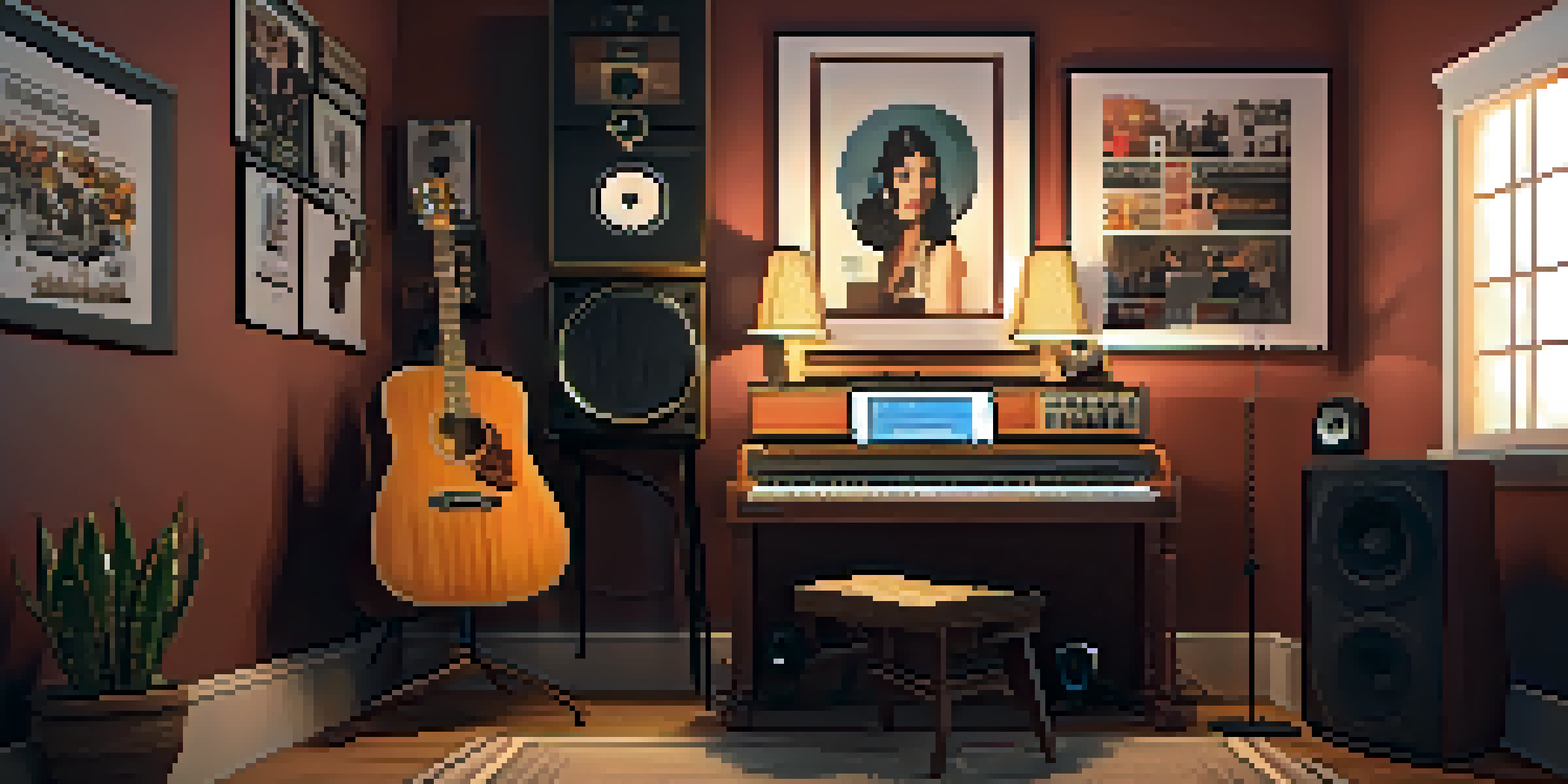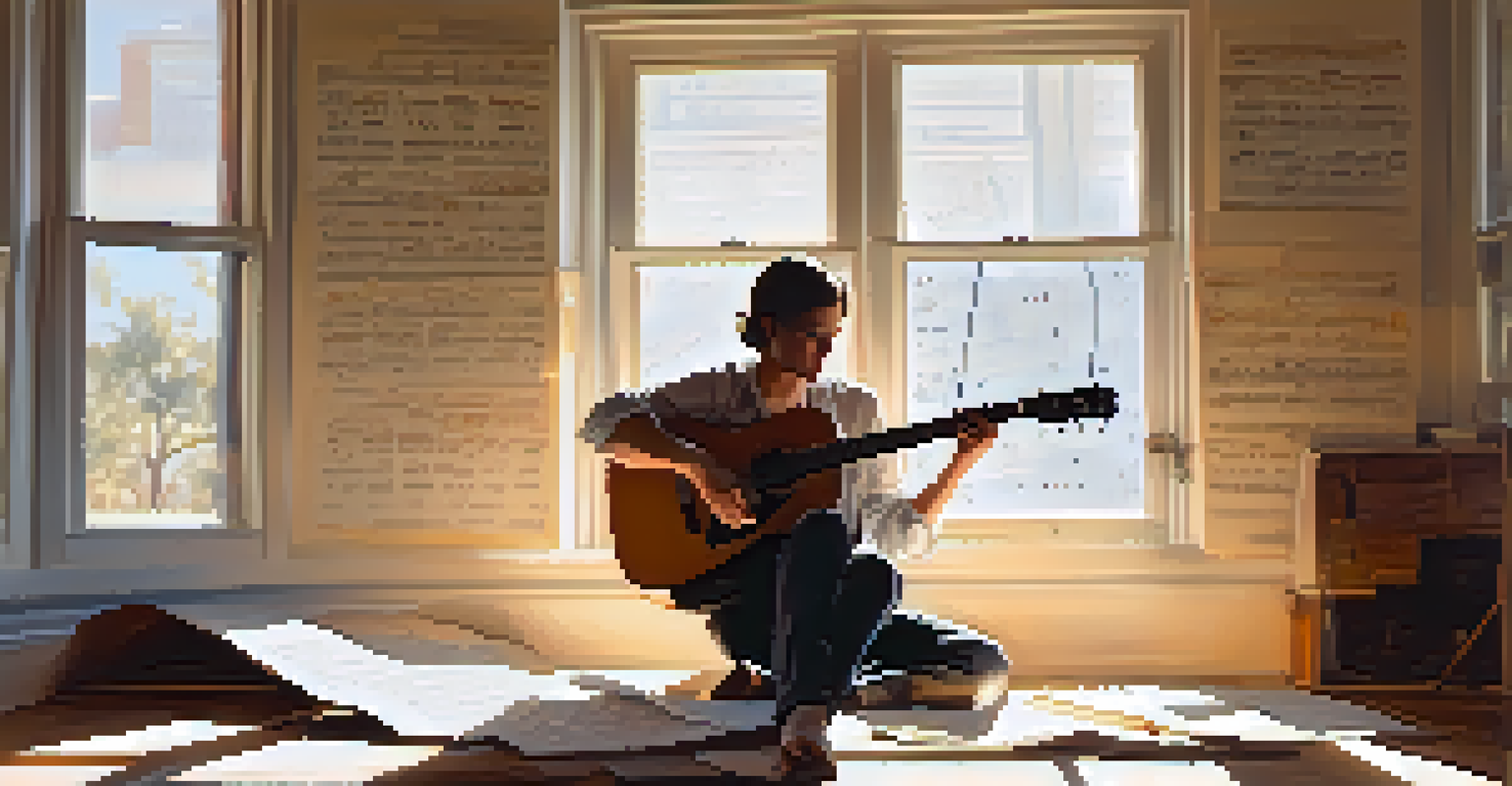How to Transform a Chord Progression into a Full Song

Understanding Your Chord Progression Basics
Before diving into song creation, it's crucial to grasp the basics of your chord progression. A chord progression is a series of chords played in sequence, and it serves as the foundation of your song. For example, the classic I-IV-V progression can evoke different emotions depending on how it's used.
Music is the shorthand of emotion.
Try playing your chord progression on an instrument, like a guitar or piano. As you do, pay attention to how it feels and what emotions it stirs within you. This will help you connect with your music on a deeper level, making it easier to build upon.
Once you’re comfortable with the progression, think about the mood you want to convey. Are you aiming for something upbeat and happy or something more melancholic? This emotional direction will guide your next steps in transforming those chords into a full song.
Crafting a Memorable Melody to Complement Your Chords
With your chords in place, it’s time to create a melody that dances around them. A melody is the tune you'll sing or play over your chords, and it should be catchy and memorable. Start by humming or singing along to your chord progression, letting spontaneous ideas flow.

Consider using different rhythmic patterns or varying your note lengths to keep your melody interesting. For instance, you could start with long, sustained notes and then switch to shorter, quicker phrases. This contrast can add depth and excitement to your overall sound.
Master Chord Progressions First
Understanding chord progressions is essential as they form the foundation of your song and influence its emotional impact.
Don't hesitate to experiment! Sometimes the best melodies come from unexpected places. Play around with different notes and intervals, and you might just stumble upon a catchy hook that makes your song unforgettable.
Building Structure: Verse, Chorus, and Bridge
A well-structured song typically includes sections like verses, choruses, and bridges. The verse tells the story or develops the theme, while the chorus is the catchy part that listeners remember. Think of the chorus as the heart of your song, where you emphasize the main message.
The beautiful thing about music is that it transcends language.
As you map out your song, consider alternating between these sections. For example, you could start with a verse, then jump to the chorus, and follow it with a bridge— a contrasting section that adds variety. This structure keeps listeners engaged and provides a sense of progression.
Experiment with different arrangements to see what flows best. Sometimes, starting with the chorus can create an exciting hook that draws listeners in right from the beginning. Trust your instincts and find a structure that feels right for your song.
Adding Lyrics: Telling Your Story
Lyrics are the words that give your song meaning and context. Start by brainstorming ideas or themes you want to convey, whether it's love, loss, or celebration. Jot down phrases or images that resonate with you, and consider how they can fit into your song structure.
As you write, think about the rhythm and flow of your words. Lyrics should complement your melody, so feel free to adjust phrases to make them fit. For instance, you might need to shorten a line to match the melody's timing better.
Create Catchy Melodies
A memorable melody should complement your chords and engage listeners, often emerging through experimentation and rhythmic variation.
Don't shy away from rewriting! Songwriting is often an iterative process, and it's normal to revise your lyrics multiple times before they feel just right. Keep refining until your lyrics resonate with the emotions you want to express.
Incorporating Instrumentation and Arrangement
Once your melody and lyrics are in place, it’s time to think about instrumentation. Decide which instruments will best support your song's mood. For a warm, acoustic feel, consider using a guitar and piano; for a more energetic vibe, you might add drums and bass.
As you arrange your song, consider dynamics—how the volume and intensity change throughout. Perhaps start softly in the verses and build up to a powerful chorus. This contrast can create an emotional journey for your listeners.
Layering different instruments can also add depth. Think of it like painting a canvas; each instrument adds a new color and texture, enhancing the overall picture. Be creative and play around with different sounds to find the perfect balance.
Recording and Producing Your Song
With everything in place, it's time to record your song. You don't need a fancy studio; many artists successfully record at home using basic equipment. Software like GarageBand or Audacity can help you capture your sound, allowing you to layer tracks and make adjustments as needed.
As you record, focus on capturing the essence of your song. Don’t worry about perfection; sometimes, the raw, unpolished moments can bring the most authenticity to your music. If you make a mistake, consider it an opportunity to add something unique to your track.
Structure Your Song Effectively
A well-structured song with verses, choruses, and bridges keeps listeners engaged and highlights the main message of your music.
Once you have your recordings, explore the production process. This includes mixing and mastering, where you'll balance the levels of different instruments and add effects. This step can elevate your song, making it sound polished and professional.
Sharing Your Song with the World
Finally, it's time to share your creation with the world! In today’s digital age, there are numerous platforms available to showcase your music, from social media to streaming services. Choose the platforms that align best with your audience and start sharing.
Consider creating a music video or visual content to accompany your song. This can help draw in listeners and give them a deeper connection to your music. A simple lyric video or an engaging behind-the-scenes clip can be effective.

Engage with your audience as you share your music. Encourage feedback and interaction, and don’t hesitate to perform live, whether online or in local venues. Sharing your song is just the beginning of your musical journey, so embrace the experience and enjoy the ride.